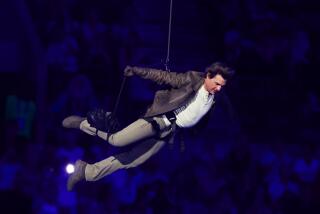A life in the balance
They SAY that seeing is believing, but “Man on Wire” will make you doubt what your eyes are telling you -- it really will -- as you shake your head in amazement and awe.
A rare double winner of both Sundance’s jury prize and its audience award for world documentary, this exhilarating film treats French aerialist Philippe Petit’s Aug. 7, 1974, walk between the twin towers of New York’s 110-story World Trade Center as if it were a daring bank robbery. This is a police procedural, if you will, about what’s been called the artistic crime of the century.
Made by director James Marsh with the human interest of a psychological drama and the “You Are There” factor of a classic doc as well as the pace of a thriller, “Man on Wire” underlines the fact that often the events most worth investigating are the ones we think we already know everything about.
That would be Petit’s 45-minute frolic on a cable stretched the 200 feet between those looming towers, which stood 1,350 feet above the ground. The 24-year-old Frenchman crossed the distance eight times and enjoyed himself so thoroughly up there that the New York City policeman who eventually arrested him called him a “tightrope dancer” and accurately noted: “I personally figured I was watching something somebody else would never see again in the world.”
Though the hubbub and good will around Petit’s exploit was immense -- President Nixon resigned two days later and when he boarded his helicopter he said, “I wish I had the publicity that Frenchman had” -- it turns out that the story behind the walk is much more complicated and involving than anyone knew at the time.
British-born filmmaker Marsh, impressively assisted by editor Jinx Godfrey, has deftly woven several strands of material together. There is heart-stopping documentary footage of Petit’s earlier walks in Paris and Sydney, astonishing photographs of his unfilmed jaunt across the towers, deftly done dramatic re-creations of behind-the-scenes events as well as interviews with the aerialist’s support team, an unlikely group of individuals who are flabbergasted to this day at what they pulled off.
Best of all is Petit himself, who turns out to be a dream subject for a documentary. Intensely dramatic and formidably articulate, he vividly relives every aspect of his moment in history as if it were yesterday. “My story is a fairy tale,” he baldly announces, and then proceeds to prove it.
Cutting back and forth between a blow-by-blow detailing of the 1974 WTC event and Petit’s earlier life, “Man on Wire” reveals that the Frenchman was obsessed with the twin towers before they were even built. Seeing a plan for them in a newspaper in a dentist’s office when he was 17 and deciding that “I must acquire my dream,” Petit brazenly ripped out the article and walked out the door.
A self-taught wire walker, Petit dreamed not of wealth or publicity but of “conquering beautiful stages,” of doing things that were, in the words of a collaborator, “against the law but not wicked or mean,” like walking between the towers of Paris’ Notre Dame Cathedral. As Annie Alix, his girlfriend at the time, says, “Every day was a work of art for him.”
Above all else, literally and metaphorically, New York’s World Trade Center towers were on his mind.
“He felt the towers were constructed just for him,” says childhood best friend and collaborator Jean-Louis Blondeau. “He could not live without trying.”
“Man on Wire” shows the months of intense planning and false starts that went into the famous walk (including the fecklessness of random American helpers) as well as near misses on the day of the event that nearly ruined everything. When Petit remembers thinking “Death is very close,” he’s not being hyperbolic.
Named after what was written on the NYPD arrest complaint handed to Petit when he returned to the building, “Man on Wire” has made the bold and quite correct decision not to so much as hint at the ultimate fate of the twin towers. What Petit did was so exceptional it deserves to be given space of its own.
Marsh’s fine documentary also emphasizes how much a work of art wire-walking is for Petit, who tried unsuccessfully to explain to American reporters that there was no “why” to what he did. He’s refused to commercialize his feat and continues to live by the philosophy that “Life should be lived on the edge of life.” “Man on Wire” is a primer on just what that means.
--
“Man on Wire.” MPAA rating: Unrated. Running time: 1 hour, 34 minutes. In limited release.
More to Read
Only good movies
Get the Indie Focus newsletter, Mark Olsen's weekly guide to the world of cinema.
You may occasionally receive promotional content from the Los Angeles Times.











